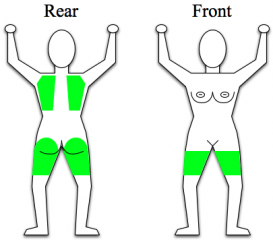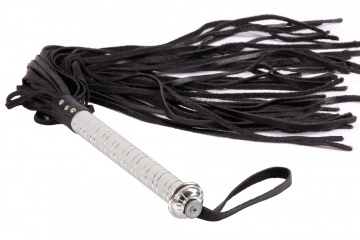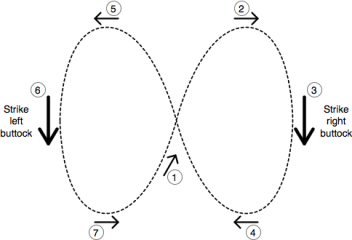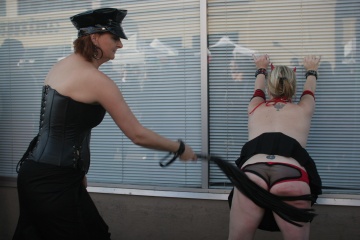 |
Peter Masters |
Peter Masters |
|
|
|||||
| About me | About this site | My books | |||||||
Practical Flogging

Figure 1. Diagram showing the safest target areas for flogging in green. Other areas are less safe and should be avoided for reasons discussed in the text

Figure 2. A basic multi-tail flogger

Figure 3. "Figure eight" flogging path. This type of flogging is used to achieve a fast strike rate. The top keeps the flogger moving by alternately swinging the flogger down on their partner's left and right buttocks and using the flogger's inertia to carry through to the next downstroke on the other side.
Flogging (along with bondage) is perhaps the most common physical BDSM activity. It is relatively simple to perform, often doesn't require specialised or expensive equipment, and can be done in a large variety of ways. There are many different ways to flog, and many ways of using a flogger or whip.
Contents
Choice of flogger
The most common floggers are the multi-tail floggers (see figure 2). They consist of a stout handle with multiple tails coming out of one end. The tails are usually made out of hair, leather, or plastic, thougn other flexible materials---such as cloth or rope---are also sometimes used. Depending on the material, how many tails, and how the flogger is used, the person on the receiving end may experience the impacts as either thuds or stings.
Thud
Thuds don't so much hurt as send shock waves through the person's body. The effect can be akin to deep body massage. When used with a heavy, slow, and regular pace these types of strokes can induce altered mind states (see subspace).
Wider tails tend to be more "thuddy" than narrower tails, particularly when the flogger has a large number of them.
Sting
Floggers with fewer and/or narrower tails can be more "stingy". Rather than a deep thud, these create a feeling of scorching, biting, or stinging.
These sorts of floggers can sometimes be used towards the end of a scene to recover someone who has gone into subspace (i.e., to get them out of subspace).
Material used in floggers
Three main factors determine how a flogger can be used and how it will feel when you're on the receiving end. These factors have to do with the tails and are:
- The length of the tails,
- The total number of tails, and
- The material from which the tails are made.
The most common materials include:
- Rubber
- Leather
- Plastic
- Hair
- Soft rope
- Chain
- Fabric
Preparation
Most flogging practitioners don't begin a flogging session by simply whaling into their partner with the heaviest flogger they have. Instead they gradually build up, starting with light strokes or caresses, possibly some spanking, before finally starting to use the heavier implements. The build up serves both the prepare the chosen target area for what is to come, as well as to let the person about to be flogged to psychologically prepare.
- Caresses by hand
- Stroking the target area with the tails of a flogger
- Spanking
- Gentle flogging with a light flogger
- Heavier flogging
Technique
Pace
Rapid strokes are useful for creating a sustained sensation, particularly for floggers whose tails are very light, such as very thin cord or hair; or with a heavier flogger once your partner is warmed up.
Slowing down the stroke rate can be important when using heavier floggers. A few seconds between strokes can allow the impact to dissipate through your partner's body and allow them better to absorb it.
Some practitioners like to randomly change the time between strokes as away of keeping their partner psychologically off-balance. That is, with regularly-paced strokes the person receiving them has a chance to psychologically prepare for each incoming stroke. This is harder to do when the strokes arrive at random times and/or with random strengths.
Wrapping
Care must be taken to only strike the desired target areas. Flogger tails can be difficult to control and getting them all to hit in the same place is a hard skill to acquire.
Thus it's relatively easy for flogger strokes to mis-hit. When using horizontal strokes on the buttocks, for example, if the flogger handle is brought too close to the buttocks the tails can reach beyond the desired target area, wrap around the hips and strike at soft tissue areas, potentially causing undesired external bruising, or---worst case---internal organ bruising or damage.
Likewise, strokes aimed at the shoulder target areas may fall on the spine, onto the neck, or wrap over the shoulders, with potentially very serious consequences and a need to consult wheelchair vendors.
Strokes

Figure 4. Horizontal buttocks flogging

Figure 5. Using two floggers at once, one in each hand
Figure 1 shows that one of the most common and convenient target areas is the buttocks. With the intended victim bent over, this target can be hit with a range of strokes.
Horizontal strokes well suit the buttocks (see figure 4). The main bulk of the flogger's tails should strike one buttock, with the tips of the tails striking the other. It's next to impossible to strike both buttocks simultaneously with a vertical stroke, but is easy with a horizontal stroke.
Vertical strokes are good for the shoulder areas. With the more bulky floggers, and for a solid hit, the flogger should be held with the tails behind your shoulder, then the flogger is swung downwards so the tails strike in one of the green target areas.
When rapid strokes are desired, the figure-8 style (see figure 3) works well. With most stroke styles you need to stop and prepare each stroke. With the figure-8 style, each downward stroke leads to the next and depending on your stamina a fast hit rate can be achieved and sustained.
Another possibility is spinning the tails around in a circle from your wrist (a bit like a propeller, or waving a flag around in a circle) and then bringing the spinning tails up against your partner's shoulder blade or buttock.
To inflict a quick sting, and if the tails are flexible enough, the flogger can be flicked against your partner's buttocks like a wet towel in a locker room.
Body changes
During a flogging scene the area being impacted can undergo various changes. These include:
- Redness as the body diverts blood to the area as it attempts to start healing the damage occurring,
- Bruising as capillaries under the skin break and blood begins the leak through the skin layers
- Abrasions as the rough edges of the flogger tails pull at and tear the skin
- Bleeding as the flogger tails tear through the skin
Safest zones to hit
Figure 1 shows the safest areas to hit in green. These are the parts of the body which either have heavy musculature or strong bones, and which don't have vital organs nearby or nerves just under the surface. These parts of the body absorb impact fairly well.
Unsafe zones to hit
It's unsafe to many areas of the body because of their sensitivity to impact. These include:
- The face, head and neck,
- Joints and parts of the body containing important nerves, including the spine, behind the knees, inside elbows, wrists and palms,
- Parts of the body containing unprotected vital organs (particularly under the rib cage around the waist), and
- Soft tissue such as breasts.
The areas in the diagram which are not green are pretty much unsafe for various reasons:
- All joints---neck, wrists, elbows, knees, etc.,
- Around the waist, both front and back, there are delicate vital organs---such as the kidney---very close to the surface,
- The floggable areas on the arms and legs between the joints are relatively small and it's easy to mis-hit and strike the joints themselves,
- Breasts and genitals are generally very sensitive and bruise easily. While a gentle flogging with a light flogger may go down well in these areas, they are no-go areas for heavier flogging, and
- The spine is a bad area to hit. Causing damage here can make your partner paraplegic.
Infection
When skin is abraded or broken this can create openings in the skin through which blood or blood plasma can leak out, and through which infections can enter the body of the person being flogged. Infections such as Hepatitis and HIV can pass this way. The fact that skin damage is occurring is sometimes not obvious, but it can occur with even the lightest and softest of floggers.
The damage can happen in different ways. Leather floggers, for example, can sometimes create small skin cuts with their edge along the length of the tails, or with the tips where they have been cut to length. Tails made of rubber can create very small tears in the skin as they pull across it at the end of each stroke. Tails made of cord or rope may have rough fibres which scrape across the skin. All floggers can potentially pick up foreign material, such as dirt or grit---particularly once they become damp with sweat---and this too can tear or abrade the surface of the skin.
To prevent infection occurring, make sure that your work area---where you’ll be laying out your floggers and other equipment---is as clean and disinfected as possible. Also make sure that your partner’s back, buttocks and wherever else you plan on striking them is clean and disinfected.
Keep your floggers clean (see below). Some types of tails can’t easily be cleaned. These include leather, cloth, hair, and cord or rope made of absorbent natural materials. Artificial fibres---particularly those which are fine and tightly woven---can also be difficult. While they may look clean, it’s very easy for small traces of blood or blood plasma to be absorbed by them and later passed to another person who is struck with the same floggers. In this case the affected floggers should be kept separate (such as in a closed plastic bag on their own) and in future be reserved only for use on that one person.
At the end of a scene clean and disinfect the parts of your partner’s body where you struck them, particularly any skin which is red, which has been bruised, or which has been obviously cut or abraded by the flogging.
Cleaning and maintaining floggers
As well as blood and blood products, skin oil and sweat also can contaminate floggers and create additional risk of cross-infections. As required, floggers should be cleaned as discussed below. It's important to note that this cleaning and other maintenance may increase the life of floggers and keep them serviceable but may not in all cases be sufficient to prevent infection or transfer of disease.
General
Floggers are commonly used on people’s bare skin and should be kept clean. Don’t leave them on the floor or in a dirty bag or dusty environment. Keep them in a dry place and out of direct sunlight which will discolour them. Don’t let the cat or dog sleep on them. Keep the tails untangled.
A good way to store a flogger is hanging in a cupboard with the tails down. Many floggers have loops on the handle which can be used for this purpose. If you have your own dungeon a small rack or a row of hooks on the wall can be ideal. These keep the flogger in a perfect position so the tails remain straight and untangled, and they also ensure the flogger is ready to grab when you need it.
The same flogger should not be used on two different people without having been cleaned in between.
Bleach
Bleach is often recommended as a treatment for floggers to disinfect them. This can work well on floggers whose tails are made of artificial materials, such as rubber or plastic, but can degrade, damage or discolour other natural materials, possibly leaving them brittle or fragile or otherwise unusable. Leather can be damaged in this way, but flogger tails made of hair, cord or rope can also be affected.
Washing
Soapy water mixed with a little hospital-grade disinfectant can be useful for cleaning the muck out of the tails of floggers. It is important to stress that soap, no matter how much you scrub or how much disinfectant it contains, is not going to remove all bugs and infections from leather and densely woven cloth or rope.
Treating leather tails
Be careful when you clean leather as sometimes it can mark or stain very easily. In general though leather tails are often best treated with leather soap or similar which you can get at leather or saddlery stores. From time to time good leather also needs a bit of oil or leather conditioner to keep it soft and pliable.
Professional leather cleaners can be an option for your more expensive leather floggers. Some types of leather, such as very soft or fine leather tails, can best be kept in good condition by being professionally treated every now and then, including being dry-cleaned to remove marks and stains.
The handle
Some types of flogger handle are made from a wooden core wrapped in leather to increase the grip. Be careful about leaving these wet as the wood can rot or fungus or mildew can form. The leather wrapping can be treated with the same sort or cleaning or oiling materials you use on the leather tails.
Plain wooden handles, if not painted or lacquered, can absorb sweat and body fluids. These can be cleaned with soapy water and disinfectant but need to be kept dry once clean.
If the handle and tails are made entirely of plastic, rubber or non-corroding metal, then leaving the flogger overnight in soapy water or bleach can be a good way to clean it after a session.